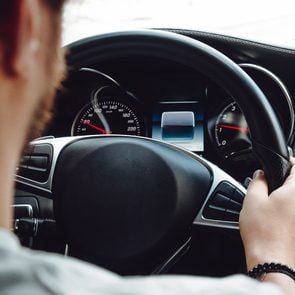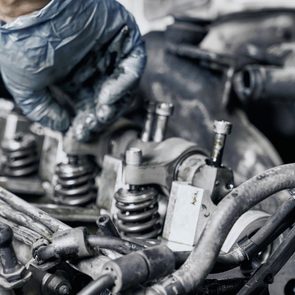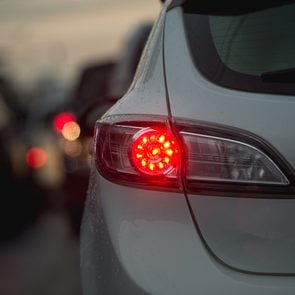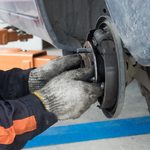What Makes a Car Backfire?

Backfiring is an auditory clue that some part in your vehicle isn't functioning properly and could be nearing the end of its service life.
Our editors and experts handpick every product we feature. We may earn a commission from your purchases.
Backfiring can sound like a throaty gurgle or a mild popping. However, if you hear what sounds like a loud firecracker exploding under your hood or coming from the tailpipe (and maybe see a flame!), that indicates there’s a problem. A car can backfire when fuel vapours ignite in the exhaust system or intake manifold instead of inside the combustion chamber. Modern computer-controlled engines manage fuel and spark delivery with exacting precision, making engine backfires in newer cars rare.
What Causes an Engine to Backfire?
These are the most common causes of engine backfire:
Air Filter
Always check the air filter first. A clogged air filter starves an engine of much-needed air, skewing the air/fuel mixture, which can cause an engine to backfire.
Out of Proportion Air/Fuel Mixture
A lean air/fuel mixture burns slower and not as hot, so some fuel may not fully burn during the combustion cycle, eventually igniting in the exhaust system. A bad oxygen sensor, mass air flow sensor, manifold pressure sensor, throttle position sensor, a stuck-open exhaust gas recirculation (EGR) valve or an engine vacuum leak can cause a lean running engine, which can cause a backfire.
A rich air/fuel mixture delivers more fuel vapour into the combustion chamber than can be burned during the combustion cycle. Any remaining unburned fuel ignites in the exhaust system. A rich fuel mixture can be caused by a malfunctioning oxygen sensor, mass air flow sensor, engine air intake sensor, coolant temperature sensor, throttle position sensor, faulty fuel or ignition system, and any of these can cause the car to backfire.
Due to the number of possible causes, diagnosing proper air/fuel mixture issues is best left to the pros.
Engine Timing
Out-of-sync ignition timing causes the ignition cycle (the spark plug firing) to begin burning the air/fuel mixture too early, or too late. Igniting the fuel too early, while the intake valves are partially open, will force the gases that are supposed to be driving the pistons down to ignite in the air intake system or carburetor. Consequently, late timing allows unburned fuel to exit the combustion chamber through the exhaust valves. Hot exhaust system parts ignite unburned fuel vapours that have mixed with oxygen, which results in backfiring from the tailpipe.
Note: Camshaft, crankshaft, throttle position and knock sensors all influence engine timing. And a loose or worn timing belt or chain can also have an impact. Sensor and timing belt/chain repairs are best left to your mechanic.
Oxygen Sensor
Oxygen (O2) sensors are a critical input sensor that effects air/fuel delivery. A contaminated, damaged or slow reacting O2 sensor results in a rich or lean air/fuel mixture and possible backfiring. Replacing an O2 sensor can be a DIY project, but you may need to have your repair shop determine if the O2 sensor is actually bad. (Find out 10 car repairs you’ve probably wasted money on.)
Fuel Injectors/Fuel System
Low or high fuel pressure from a dirty fuel filter, defective fuel pump, clogged fuel tank strainer, bad fuel regulator or fuel injectors that are dirty, clogged, slow acting, partially stuck open, leaking or damaged, can adversely affect the air/fuel mixture. Try replacing the fuel filter and adding a fuel injector cleaning treatment to your fuel tank. If this doesn’t do the trick, it’s time to bring your car in for service.
Ignition Systems
Most vehicles today have a distributorless, coil-over-plug ignition system (COP) that eliminates spark plug wires and distributor cap. Dirty or worn spark plugs, weak or no spark from a failing coil prevents fuel from completely burning in the combustion chamber. Replacing spark plugs is a DIY operation. However, diagnosing and replacing coils is best left to your mechanic.
Leaky Exhaust
Exhaust gas flowing over a leak in the exhaust system manifold, header pipe or sealing gasket creates a vacuum that sucks in fresh air. The oxygen-rich fresh air helps partially burned fuel in the exhaust gas ignite and backfire. This fix is for the pros.
Mechanical Failures
Unfortunately, there are several expensive mechanical failures that can also cause backfiring. These include burned or cracked engine valves, weak or broken valve springs or a camshaft with a worn lobe. Leave these repairs to the experts.
Older Car Engines
Carbureted and non-computer-controlled engines often had backfiring issues. Carburetors constantly need manual adjusting to maintain correct air/fuel mixture. Besides bad spark plugs and coils, long spark plug wires on older cars are a major cause of engine misfire and subsequent backfiring. Spark plug wires need to be connected in a specific, sequential order, called the firing order. Spark plugs firing out of sequence will cause an engine to backfire. Also, wires haphazardly installed or not routed properly (too close to each other, rubbing against an engine part, bent at a weird angle or stretched taut) can cause them to “short circuit.” When this happens, the ignition spark jumps from one wire to another, or to ground, resulting in spark plugs firing at the wrong time or not at all.
And, let’s not forget the distributor cap. Moisture inside a distributor cap will cause carbon tracking. Tracking causes the spark meant for one cylinder to “track” to another cylinder. This causes the spark plugs to fire when they shouldn’t, and worse, not fire when they should.
Replacing the spark plugs, spark plug wires, distributor cap (and rotor) are DIY operations. (Find out 20 essential auto tools no home mechanic should be without.)
What to Do If Your Car Backfires?
If you hear a backfire from your computer-controlled engine built after 1996, immediately check if the Check Engine Light is on. The computer may engage “Limp Home Mode” to reduce engine power to protect the drivetrain from damage caused by backfiring. It’s time to drive slowly to your mechanic.
If the backfire sounds like a muffled pop or low rumble, let the engine cool down, then inspect under the hood for disconnected or damaged hoses and frayed wires. With the engine running, carefully listen for an exhaust leak and or a hissing or sucking noise indicating a vacuum leak. Wire and hose repairs are DIY fixes.
Backfiring should be diagnosed and repaired to prevent engine or exhaust system damage and poor fuel economy.
Next, find out what these nine strange car noises could mean.






